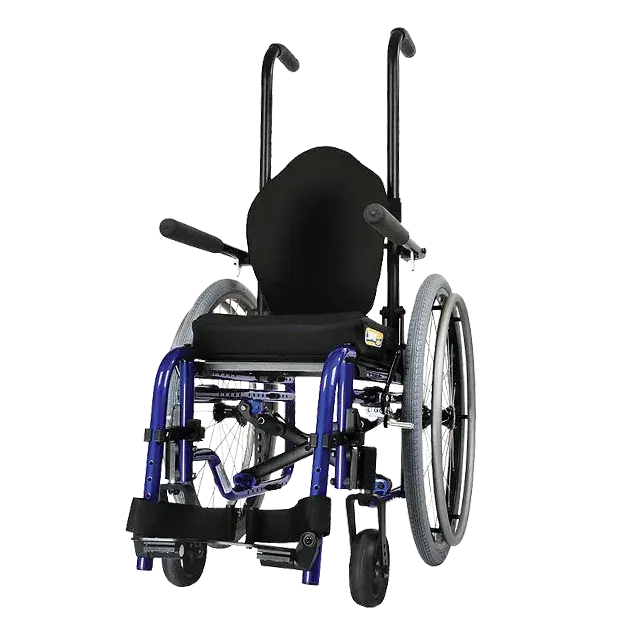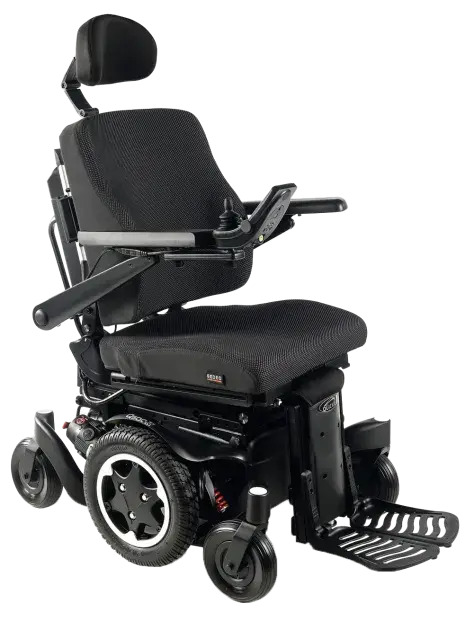
Mobility Possibilities: Answers to Frequently Asked Questions About Electric Wheelchairs
Powered Wheelchairs
Mobility is a fundamental aspect of independence and well‑being. For those who face difficulty getting around, powered wheelchairs offer an innovative solution that goes beyond mere transportation. These devices provide freedom, autonomy, and comfort, allowing users to carry out daily activities without constant assistance.
Thanks to technological advances, powered wheelchairs have evolved to suit different lifestyles, environments, and individual needs. From compact models for tight spaces to those built for rough terrains, there's a wide variety of options on the market. However, choosing the right chair can be challenging.
In this blog, we’ll explore everything you need to know about powered wheelchairs. Whether you're seeking to improve your quality of life or that of a loved one, this guide will be very helpful.
What is a powered wheelchair and how does it work?
Powered wheelchairs are mobility devices designed for people who have difficulty moving independently. Unlike manual wheelchairs, which require physical effort or assistance to move, powered models have a motor and control system that allows easy, effort‑free movement.
How does it work?
Powered wheelchairs run on rechargeable batteries that power one or more electric motors. They consist of the following key components:
-
Electric motor: provides the energy for movement. Depending on the model, the chair may have one or two motors.
-
Battery: usually lithium or lead‑acid, offering autonomy for several hours of use.
-
Joystick or control unit: located on one armrest, allows the user to steer the chair precisely, controlling speed and direction.
-
Chassis and wheels: designed to provide stability and adapt to different terrains.
-
Brake system: in many models, activates automatically when the control is released.
Some powered wheelchairs feature advanced technology like voice control, Bluetooth connectivity, or intelligent navigation systems, further enhancing functionality and comfort.

This type of device not only facilitates mobility but also improves the quality of life and autonomy of users, enabling them to perform daily tasks more independently.
Benefits of using powered wheelchairs
Using powered wheelchairs offers numerous advantages for people with reduced mobility. Thanks to their technology and ease of use, they improve autonomy, comfort, and quality of life. Here are the main benefits:
-
Greater independence and autonomy: powered wheelchairs allow users to move around without needing assistance, facilitating mobility indoors and outdoors. This contributes to greater daily independence.
-
Less physical effort: unlike manual wheelchairs, powered ones require no arm strength to propel. This is especially beneficial for people with limited upper‑body strength or medical conditions affecting movement.
-
Enhanced comfort and ergonomics: these devices are designed for long‑term comfort. Many models include padded seats, adjustable armrests, and suspension systems that reduce impact on uneven terrain.
-
Increased safety: powered wheelchairs feature automatic braking, improved stability, and speed control, reducing the risk of accidents or falls.
-
Mobility across different environments: some models are designed for varied terrains, from smooth indoor surfaces to streets, sidewalks, and parks outdoors.
-
Improved quality of life: being able to move easily and independently boosts self‑esteem and the feeling of freedom, promoting a more active and socially integrated life.
-
Advanced technological options: models with voice control, Bluetooth connection, adjustable tilt, and intelligent navigation make use and customization even easier.
Powered wheelchairs are an investment that not only improves mobility but also enhances well‑being and autonomy in daily life.
Types of powered wheelchairs and how to choose the right one
Powered wheelchairs have evolved to meet different needs and lifestyles. There are multiple models with specific features to offer more comfort, autonomy, and safety. Here are the main types and guidance on choosing the right one.
Indoor powered wheelchairs
- Designed to maneuver in tight spaces.
- Compact, lightweight, and highly maneuverable.
- Ideal for home, office, or indoor venues.
Outdoor powered wheelchairs
- Built with larger wheels and robust suspension.
- Capable of navigating uneven surfaces like streets or parks.
- Greater battery autonomy for longer use.
Portable (folding) powered wheelchairs
- Easy to transport and store.
- Folds to fit in vehicles or compact spaces.
- Perfect for frequent travelers.

All‑terrain powered wheelchairs
- Designed for rough terrains like gravel, grass, or sand.
- Equipped with rugged tires and powerful motors.
- Perfect for outdoor activities and adventurous users.
Powered wheelchairs with specific drive systems
- Front-wheel drive: greater stability and good performance in tight spaces.
- Rear-wheel drive: higher speed and smooth outdoor movement.
- Mid-wheel drive: excellent maneuverability and turning on the spot.
Custom‑built powered wheelchairs
- Designed to meet the user's specific needs.
- Can include special controls, adjustable tilt, electric footrests, and more.
To select the best option, consider:
- User’s mobility needs, comfort, and desired autonomy.
- Type of use: primarily indoor, outdoor, or both?
- Portability: if frequent transport is needed.
- Battery autonomy: based on daily travel distance.
- Weight and load capacity: to ensure stability and safety.
- Additional features: like adjustable armrests, smart controls, or connectivity.
Choosing the right powered wheelchair is key to improving quality of life and ensuring safe, efficient mobility.
Maintenance and care of a powered wheelchair
To ensure optimal performance and extend the service life of a powered wheelchair, proper maintenance is essential. Here are key care recommendations.
Battery inspection and care
- Charge properly: follow the manufacturer's instructions and avoid letting the battery fully discharge frequently.
- Avoid overcharging: don’t leave it connected longer than recommended.
- Clean terminals: use a dry cloth to prevent dust or corrosion build‑up.
- Replace when needed: if the battery lasts less than usual, consider replacing it.
Cleaning and chassis care
- Clean regularly: use a damp cloth to remove dust and dirt.
- Avoid extreme moisture: don’t expose the chair to rain or puddles to prevent electrical damage.
- Check screws and loose parts: ensure everything is securely fastened.
Wheel inspection
- Check tire pressure and condition: if the wheels are pneumatic, ensure they are properly inflated.
- Clean wheels regularly: remove debris that may hinder movement.
- Check wear: replace wheels if they lose traction.
Control system check
- Test controls periodically: ensure the joystick and other controls respond correctly.
- Inspect wiring: prevent exposed wires or loose connections.
Professional maintenance
- Regular technical service: a professional check‑up at least once a year is recommended.
- Follow manufacturer guidelines: each model may have specific care requirements.
With proper maintenance, powered wheelchairs can offer years of safe and efficient mobility.
Frequently Asked Questions
1. How long does a powered wheelchair battery last?
It varies by model and usage, but generally ranges between 8 and 20 km per charge.
2. How much weight can a powered wheelchair support?
It depends on the model, but most support between 100 and 150 kg. Reinforced models are available for higher capacity.
3. How do I transport a powered wheelchair?
Some are foldable, while others require a vehicle with a ramp or lift.
4. How often should I perform maintenance?
A general check‑up every 6 months and a professional service annually is recommended.
5. What if the battery dies while I'm away from home?
Many chairs can be pushed manually, or you can carry an extra battery if the model allows it.
Powered wheelchairs represent an innovative solution to improve mobility and quality of life for people with disabilities or reduced mobility. Thanks to advanced technology, they offer independence, comfort, and safety in various environments.
To choose the ideal chair, it's essential to consider individual needs, terrain type, and model features. Additionally, good maintenance ensures durability and optimal performance.
At Loh Medical, we understand the importance of having a powered wheelchair tailored to each person. That’s why we offer specialized advice and a wide variety of models so you can find the best option.
Contact us today and discover how we can help you improve your mobility!






